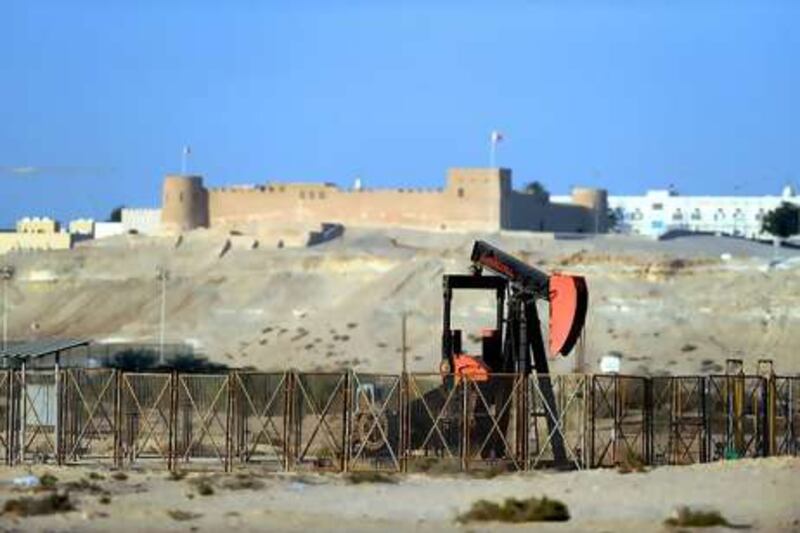MANAMA // Gulf oil producers are sticking to plans to boost output capacity in the face of lingering doubts about the pace of global economic recovery and a modest outlook for demand. Most significantly, Iraq's oil ministry has pledged to boost capacity to as much as 12 million barrels per day (bpd) of crude by 2017, from the country's current 2.5 million bpd.
However, most analysts are sceptical that the plan is realistic. "Iraq's new expansion timetable would dwarf the most rapid build-ups that we have recently seen in places such as Russia and Saudi Arabia," the international consulting company IHS CERA said recently. "The political, security, operational and infrastructure challenges in the country, along with a likely shortage of skilled personnel, are likely to hamper progress towards such an unprecedented achievement."
But, if Iraq's huge oil expansion progresses more slowly than Baghdad has signalled, there are plenty of neighbours preparing to take up the slack. The biggest, Saudi Arabia, plans US$90 billion (Dh330.57bn) of investment in oil and gas development from this year to 2015, Khalid al Falih, the chief executive of Saudi Aramco, the national oil company, said in March. That follows $62bn of investment over the previous five years, which pushed Saudi oil production capacity to 12 million bpd just as OPEC commitments forced the kingdom to cut its actual output to 8 million bpd.
"This was not the intention; we overshot the market," Mr al Falih told an oil conference in Houston. "We thought that by now we would be producing 10 million [bpd]." The ambitious new investment programme is aimed at maintaining Saudi capacity and providing a platform for future increases. "Every time we have invested in spare capacity we eventually have recovered our investment," Mr al Falih told Forbes magazine.
The smaller Gulf oil producers are eying higher crude output sooner rather than later. In the UAE, Abu Dhabi National Oil Company (ADNOC) plans to raise capacity to 3.5 million bpd by 2018, from about 2.8 million bpd. Since the beginning of last year, operating units of the state-owned oil company have signed billions of dollars of deals with international contractors for work to boost output from Abu Dhabi's biggest onshore and offshore oilfields, while moving to develop some smaller untapped fields.
In addition, Mubadala Development, a strategic investment company owned by the Abu Dhabi Government, is in a joint venture with the US oil company Occidental Petroleum and the Bahrain government's National Oil and Gas Authority to increase output from Bahrain's only oilfield. The Bahrain oilfied, also called Awali, produces about 32,000 bpd. "Our target is 100,000 bpd," Abdulhussain Mirza, the Bahraini oil minister, told an oil conference in Manama on Monday.
Mubadala and Occidental are also partners in an Omani oil project, where they have recently increased production to 90,000 bpd from 80,000 bpd and are aiming to boost output to 150,000 bpd within five years. In the past two years, Oman, the smallest oil exporter in the GCC, has reversed a production decline that lasted several years. The consulting group Business Monitor International (BMI), however, doubts that is sustainable. Last month, it forecast a "steady decline" in Omani crude output to 577,000 bpd in 2019, from a peak of 835,000 bpd expected this year.
Any decrease in Omani output, though, is likely to be more than offset by higher oil production from Qatar, the smallest of the OPEC oil exporters. Qatar is better known for its vast gas reserves, some of which it will start converting into as much as 140,000 bpd of synthetic oil products later this year. That is due to begin when the world's biggest gas-to-liquids (GTL) plant, a joint venture between Qatar Petroleum and Royal Dutch Shell, starts operations.
The emirate already produces 40,000 bpd of synthetic oil from a smaller GTL plant. It is also increasing output capacity at its largest offshore oilfield, Al Shaheen. Following the recent completion of a $6bn expansion of production facilities, it expects to be able to pump 525,000 bpd of crude from the field instead of the current 300,000 bpd. The remaining GCC oil producer, Kuwait, could raise its crude output to 2.9 million bpd in 2014 from about 2.6 bpd, subject to OPEC quotas, BMI forecasts. The state oil company Kuwait Petroleum Corporation is determined to expand capacity despite stiff parliamentary opposition to foreign involvement in the emirate's oil and gas sector. Even going it alone, the company could lift the country's oil output "steadily" to 3.6 million bpd in 2019, BMI suggests, matching the UAE's projected capacity.
For the entire Middle East, BMI foresees steady growth in oil exports "because demand growth is lagging behind the pace of supply expansion". That is despite significant growth of 8 per cent expected in regional oil consumption from last year to 2014. BMI projects Middle East oil output reaching 27.19 million bpd by 2014, up 9.5 per cent from 24.83 million bpd last year. "Iraq has the greatest production growth potential, followed by Qatar," the company said last month in its latest forecast for the region.
tcarlisle@thenational.ae





